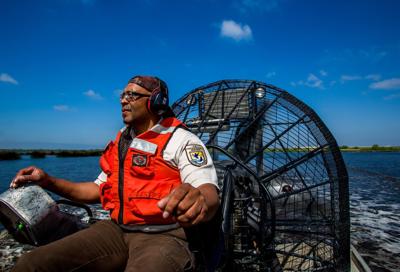New Orleans has something uniquely wild in its northeast corner. Bayou Sauvage is the largest national wildlife refuge that's completely within a city. Not far from tall buildings, crowded streets and busy shopping strips, the 30,000-acre swath of forest and marsh is a haven for deer, snakes, alligators and more than 340 species of birds.
Pon Dixson has been helping to take care of Bayou Sauvage National Urban Wildlife Refuge for the better part of 30 years. While the biologist-turned-refuge manager has witnessed swaths of the refuge disappear from storms and coastal erosion, he says there's still so much to enjoy and defend. The refuge is one of the last marsh areas adjacent to Lakes Pontchartrain and Borgne, and it offers urban kids a taste of Louisiana's wild side.
A graduate of Grambling State University, Dixson is working hard to build a pipeline for young Black scientists and conservationists to take his place at Bayou Sauvage and other natural landscapes in the South.
He spoke to The Times-Picayune | The Advocate about Bayou Sauvage and his career with the U.S. Fish and Wildlife Service in a conversation that has been edited for length and clarity.

A bird flies in the Bayou Sauvage Urban National Wildlife Refuge in New Orleans on Wednesday, April 26, 2023. (Photo by Brett Duke, NOLA.com | The Times-Picayune)
How did you become interested in wildlife and natural landscapes?
I grew up in a little rural community in north Louisiana called D’Arbonne. About the only thing you can do there is fish, hunt and hike. I just took a liking to all that and decided it was what I wanted to do for a living.
How did you become involved in Fish and Wildlife?
I attended college and started out majoring in regular biology. One day, a guy came by who was looking for minorities who’d like to work in the wildlife field. The head of the biology department suggested he come talk to me. They asked me if I'd be interested in doing wildlife biology, and I’m like ‘Sure, it's my lifelong dream.’ When they started recruiting to have more minority representation within this organization, I just took advantage of an opportunity to showcase my skills and abilities.
My first job was working with the Grambling Cooperative Wildlife Project, which was a program sponsored by Fish and Wildlife. I worked in a parasitology laboratory doing studies on raccoon parasites.

Bayou Sauvage National Wildlife Refuge in New Orleans East in 2011.
Bayou Sauvage isn't a typical wildlife refuge. How's it different?
What makes us really unique is that we’re urban. We’re the second largest urban refuge in the national wildlife refuge system. However, it is the only urban refuge that is truly urban because the entire refuge is located within the city limits of New Orleans. Other urban refuges are located adjacent to metropolitan areas like San Francisco Bay (National Wildlife Refuge).
And then we have really interesting wildlife. We have a very large population of canebrake rattlesnakes, and of course the numerous alligators. I really like the fishing opportunities. You can catch shrimp, crabs, crawfish, sac a lait, green trout, speckled trout, redfish. You don’t have to leave the city and you can catch all these species and also get in you some bird watching and get in you some kayaking, too.
We characterize the refuge as the other wildlife place in New Orleans. Most people come for the wildlife that you see on Bourbon, Frenchmen Street and all that. But you can escape the French Quarter and come out to Bayou Sauvage and see some of the really true wildlife species.
What are some of the challenges the refuge faces?
Our biggest challenge with the refuge is illegal dumping and educating people on the importance of keeping the environment as pristine as possible. People dump large amounts of trash – all kinds of litter, tires, old furniture.
The Louisiana coast is experiencing a lot of land loss. How much of a problem is that at the refuge?
Our brackish marshes have experienced significant land loss. In my early career, we posted a boundary post 20 feet up from the marsh. Now that same marker is 100 feet in open water. In some places, there’s more than 100 feet of shoreline loss. But there are some restoration projects taking place to address the land loss.

A crew works to remove harnesses from bundles of Christmas trees that were dropped by a helicopter in the Bayou Sauvage Urban National Wildlife Refuge in New Orleans on Wednesday, April 26, 2023. (Photo by Brett Duke, NOLA.com | The Times-Picayune)
Like using old Christmas trees?
The Christmas tree project has been very successful. With the project, we have some marsh (growth) in the freshwater impoundments. But I don’t think that project and other restoration projects come close to the amount of marsh we’ve lost due to high wave energy in the more brackish areas.
You’re known for being a mentor to younger Black men and women in the sciences. I understand you go back to Grambling and give talks and do recruiting.
Not only Grambling, but also LSU, Mississippi State, Auburn. I spent a lot of time doing that. It's near and dear to me, and I do it on my own time. Diversity is the key to success for all of humanity and also the wildlife world. The more variety and diversity you have in an ecosystem, the more likely that ecosystem is going to be successful. If you take away the diversity in the ecosystem, it soon crashes.




















